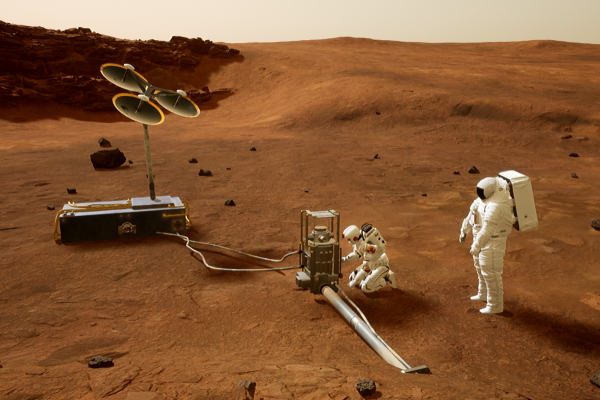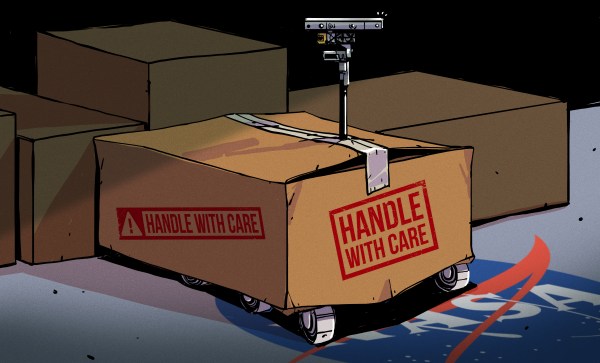The big news this week comes from the world of medicine, where a woman has received a 3D-printed ear transplant. The 20-year-old woman suffered from microtia, a rare congenital deformity that left her without a pinna, the external structure of the ear. Using scans of the normal ear, doctors were able to make a 3D model of what the missing pinna should look like. Raw material for the print was taken from the vestigial ear of the patient in the form of cartilage cells, or chondrocytes. The ear was printed using a bioprinter, which is a bit like an inkjet printer. The newly printed ear was placed into a protective structure and transplanted. The operation was done in March, and the results are pretty dramatic. With a little squinting, it does look a bit like there are some printing artifacts in the ear, but we’d imagine that’s more from the protective cage that was over the ear as it healed.
mars107 Articles
Hackaday Links: May 22, 2022
It looks like it’s soon to be lights out for the Mars InSight lander. In the two years that the lander has been studying the geophysics of Mars from its lonely post on Elysium Planitia, InSight’s twin solar arrays have been collecting dust, and now are so dirty that they’re only making about 500 watt-hours per sol, barely enough to run the science packages on the lander. And that’s likely to worsen as the Martian winter begins, which will put more dust in the sky and lower the angle of the Sun, reducing the sunlight that’s incident to the panels. Barring a “cleaning event” courtesy of a well-placed whirlwind, NASA plans to shut almost everything down on the lander other than the seismometer, which has already captured thousands of marsquakes, and the internal heaters needed to survive the cold Martian nights. They’re putting a brave face on it, emphasizing the continuing science and the mission’s accomplishments. But barely two years of science and a failed high-profile experiment aren’t quite what we’ve come to expect from NASA missions, especially one with an $800 million price tag.
Closer to home, it turns out there’s a reason sailing ships have always had human crews: to fix things that go wrong. That’s the lesson learned by the Mayflower Autonomous Ship as it attempted the Atlantic crossing from England to the States, when it had to divert for repairs recently. It’s not clear what the issue was, but it seems to have been a mechanical issue, as opposed to a problem with the AI piloting system. The project dashboard says that the issue has been repaired, and the AI vessel has shoved off from the Azores and is once more beating west. There’s a long stretch of ocean ahead of it now, and few options for putting in should something else go wrong. Still, it’s a cool project, and we wish them a fair journey.
Have you ever walked past a display of wall clocks at the store and wondered why someone went to the trouble of setting the time on all of them to 10:10? We’ve certainly noticed this, and always figured it had something to do with some obscure horological tradition, like using “IIII” to mark the four o’clock hour on clocks with Roman numerals rather than the more correct “IV”. But no, it turns out that 10:10 is more visually pleasing, and least on analog timepieces, because it evokes a smile on a human face. The study cited in the article had volunteers rate how pleasurable watches are when set to different times, and 10:10 won handily based on the perception that it was smiling at them. So it’s nice to know how easily manipulated we humans can be.
If there’s anything more pathetic than geriatric pop stars trying to relive their glory days to raise a little cash off a wave of nostalgia, we’re not sure what it could be. Still, plenty of acts try to do it, and many succeed, although seeing what time and the excesses of stardom have wrought can be a bit sobering. But Swedish megastars ABBA appear to have found a way to cash in on their fame gracefully, by sending digital avatars out to do their touring for them. The “ABBA-tars,” created by a 1,000-person team at Industrial Light and Magic, will appear alongside a live backing band for a residency at London’s Queen Elizabeth Olympic Park. The avatars represent Benny, Bjorn, Agnetha, and Anni-Frid as they appeared in the 1970s, and were animated thanks to motion capture suits donned while performing 40 songs. It remains to be seen how fans will buy into the concept, but we’ll say this — the Swedish septuagenarians look pretty darn good in skin-tight Spandex.
And finally, not that it has any hacking value at all, but there’s something shamefully hilarious about watching this poor little delivery bot getting absolutely wrecked by a train. It’s one of those food delivery bots that swarm over college campuses these days; how it wandered onto the railroad tracks is anyone’s guess. The bot bounced around a bit before slipping under the train’s wheels, with predictable results once the battery pack is smooshed.
Can You Help NASA Build A Mars Sim In VR?
No matter your project or field of endeavor, simulation is a useful tool for finding out what you don’t know. In many cases, problems or issues aren’t obvious until you try and do something. Where doing that thing is expensive or difficult, a simulation can be a low-stakes way to find out some problems without huge costs or undue risks.
Going to Mars is about as difficult and expensive as it gets. Thus, it’s unsurprising that NASA relies on simulations in planning its missions to the Red Planet. Now, the space agency is working to create a Mars sim in VR for training and assessment purposes. The best part is that you can help!
Continue reading “Can You Help NASA Build A Mars Sim In VR?”
Hackaday Links: May 1, 2022
We start this week with news from Mars, because, let’s face it, the news from this planet isn’t all that much fun lately. But a couple of milestones were reached on the Red Planet, the first being the arrival of Perseverance at the ancient river delta it was sent there to explore. The rover certainly took the scenic route to get there, having covered 10.6 km over the last 424 sols to move to a position only about 3.5 km straight-line distance from where it landed. Granted, a lot of that extra driving was in support of the unexpectedly successful Ingenuity demonstration, plus taking time for a lot of pit stops along the way at interesting features. But the rover is now in place to examine sedimentary rocks most likely to harbor the fossil remains of ancient aquatic life — as opposed to the mainly igneous rocks it has studied along the crater floor so far. We’re looking forward to seeing what happens.
Mothballing Rosalind: How To Put A Space Mission In Storage
In planetary exploration circles, Mars has quite a bad reputation. The Red Planet has a habit of eating spacecraft sent there to explore it, to the degree that nearly half of the missions we’ve thrown at it have failed in one way or another. The “Mars Curse” manifests itself most spectacularly when landers fail to negotiate the terminal descent and new billion-dollar craters appear on the Martian regolith, while some missions meet their doom en route to the planet, and an unlucky few have even blown up on the launchpad.
But the latest example of the Mars Curse, the recent cancellation of the second half of the ExoMars mission, represents a new and depressing failure mode: war — specifically the Russian invasion of Ukraine. The international outrage over the aggression resulted in economic sanctions and diplomatic isolation of Russia, which retaliated by ending its partnership with the European Space Agency (ESA), depriving the mission of its launch vehicle and dooming the mission that would have landed the rover Rosalind Franklin on Oxia Planum near the Martian Equator in 2023.
While there’s still a chance that administrators and diplomats will work things out, chances are slim that it will be in time for the narrow launch window that the mission was shooting for in September of 2022. That means the Rosalind Franklin, along with all the other flight hardware that was nearly ready to launch, will have to be put in storage at least until the next launch window opens in 2024. That begs the question: how does one put a complex spacecraft into storage? And could such mothballing have unintended consequences for the mission when it eventually does fly?
Continue reading “Mothballing Rosalind: How To Put A Space Mission In Storage”
Hackaday Links: April 10, 2022
A funny thing happened on the way to the delta. The one on Jezero crater on Mars, that is, as the Perseverance rover may have captured a glimpse of the parachute that helped deliver it to the Red Planet a little over a year ago. Getting the rover safely onto the Martian surface was an incredibly complex undertaking, made all the more impressive by the fact that it was completely autonomous. The parachute, which slowed the descent vehicle holding the rover, was jettisoned well before the “Sky Crane” deployed to lower the rover to the surface. The parachute wafted to the surface a bit over a kilometer from the landing zone. NASA hasn’t confirmed that what’s seen in the raw images is the chute; in fact, they haven’t even acknowledged the big white thing that’s obviously not a rock in the picture at all. Perhaps they’re reserving final judgment until they get an overflight by the Ingenuity helicopter, which is currently landed not too far from where the descent stage crashed. We’d love to see pictures of that wreckage.
Hackaday Links: March 6, 2022
As if the war in Ukraine weren’t bad enough right here on Earth, it threatens knock-on effects that could be felt as far away as Mars. One victim of the deteriorating relationships between nations is the next phase of the ExoMars project, a joint ESA-Roscosmos mission that includes the Rosalind Franklin rover. The long-delayed mission was most recently set for launch in October 2022, but the ESA says that hitting the narrow launch window is now “very unlikely.” That’s a shame, since the orbital dynamics of Earth and Mars will mean that it’ll be 2024 before another Hohmann Transfer window opens. There are also going to be repercussions throughout the launch industry due to Russia pulling the Soyuz launch team out of the ESA’s spaceport in Guiana. And things have to be mighty tense aboard the ISS right about now, since the station requires periodic orbital boosting with Russian Progress rockets.













